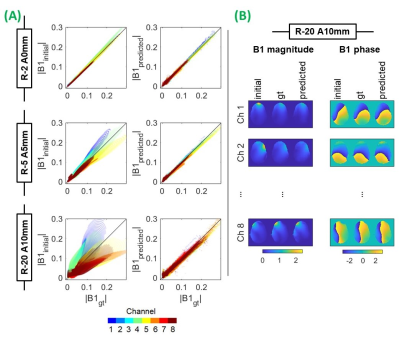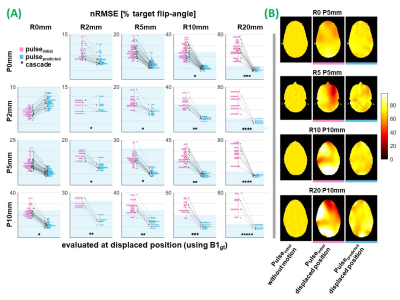Alix Plumley1, Luke Watkins1, Kevin Murphy1, and Emre Kopanoglu1
1Cardiff University Brain Research Imaging Centre, Cardiff, United Kingdom
1Cardiff University Brain Research Imaging Centre, Cardiff, United Kingdom
We present a deep learning approach to estimate motion-resolved parallel-transmit B1+ distributions using a system of conditional generative adversarial networks. The estimated maps can be used for real-time pulse re-design, eliminating motion-related flip-angle error.

Fig.4(A) Voxelwise magnitude
correlations between B1initial (initial position) and B1gt (ground-truth
displaced) [left] and B1predicted (network predicted displaced) and
B1gt [right]. Small (top), medium (middle) and large (bottom) displacements are shown. Phase data not shown. (B) Magnitude
(in a.u.) and phase (radians) B1-maps for the largest displacement.
Left, middle and right: B1initial, B1gt and
B1predicted, respectively. B1predicted
quality did not depend heavily on displacement magnitude and remained high
despite 5 network cascades for evaluation at R-20 A10mm.

Fig.3(A) Motion-induced
flip-angle error for pTx pulses designed using B1initial
(conventional method, pink) & B1predicted (proposed method,
blue) at all evaluated positions & slices. Y-axes show nRMSE (% target
flip-angle). nRMSE of all pulsespredicted is at/below the shaded
region. Asterisks show number of network cascades required for evaluation. (B) Example profiles. Left: evaluation for pulseinitial
without motion. Middle & right: evaluations at
B1gt (displaced position) using pulseinitial & pulsepredicted,
respectively. Colorscale shows flip-angle (target=70°).
